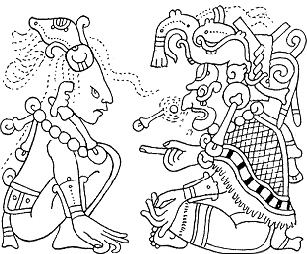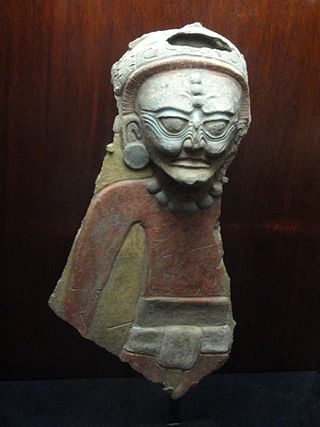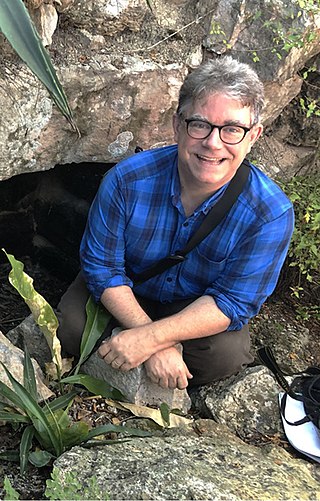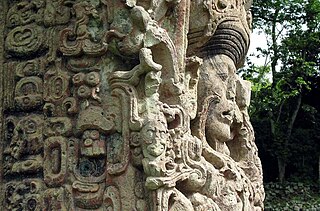
Mayan or Maya mythology is part in of Mesoamerican mythology and comprises all of the Maya tales in which personified forces of nature, deities, and the heroes interacting with these play the main roles. The legends of the era have to be reconstructed from iconography. Other parts of Mayan oral tradition are not considered here.

The representation of jaguars in Mesoamerican cultures has a long history, with iconographic examples dating back to at least the mid-Formative period of Mesoamerican chronology.

Maya codices are folding books written by the pre-Columbian Maya civilization in Maya hieroglyphic script on Mesoamerican bark paper. The folding books are the products of professional scribes working under the patronage of deities such as the Tonsured Maize God and the Howler Monkey Gods. The codices have been named for the cities where they eventually settled. The Dresden codex is generally considered the most important of the few that survive.

Tatiana Proskouriakoff was a Russian-American Mayanist scholar and archaeologist who contributed significantly to the deciphering of Maya hieroglyphs, the writing system of the pre-Columbian Maya civilization of Mesoamerica.

Michael Douglas Coe was an American archaeologist, anthropologist, epigrapher, and author. He is known for his research on pre-Columbian Mesoamerica, particularly the Maya, and was among the foremost Mayanists of the late twentieth century. He specialised in comparative studies of ancient tropical forest civilizations, such as those of Central America and Southeast Asia. He held the chair of Charles J. MacCurdy Professor of Anthropology, Emeritus, Yale University, and was curator emeritus of the Anthropology collection in the Peabody Museum of Natural History, where he had been curator from 1968 to 1994.

Nebaj is an archaeological site of the pre-Columbian Maya civilization, located in the western Guatemala highlands near the Ixil village of Santa Maria Nebaj. What is now known as the Fenton Vase was excavated from this site. It is now held in the British Museum.
Ancient Maya art comprises the visual arts of the Maya civilization, an eastern and south-eastern Mesoamerican culture made up of a great number of small kingdoms in present-day Mexico, Guatemala, Belize and Honduras. Many regional artistic traditions existed side by side, usually coinciding with the changing boundaries of Maya polities. This civilization took shape in the course of the later Preclassic Period, when the first cities and monumental architecture started to develop and the hieroglyphic script came into being. Its greatest artistic flowering occurred during the seven centuries of the Classic Period.

Tikal Temple I is the designation given to one of the major structures at Tikal, one of the largest cities and archaeological sites of the pre-Columbian Maya civilization in Mesoamerica. It is located in the Petén Basin region of northern Guatemala. It also is known as the Temple of the Great Jaguar because of a lintel that represents a king sitting upon a jaguar throne. An alternative name is the Temple of Ah Cacao, after the ruler buried in the temple. Temple I is a typically Petén-styled limestone stepped pyramid structure that is dated to approximately 732 AD.

Karl Andreas Taube is an American Mesoamericanist, Mayanist, iconographer and ethnohistorian, known for his publications and research into the pre-Columbian cultures of Mesoamerica and the American Southwest. He is Distinguished Professor of Anthropology at the College of Humanities, Arts, and Social Sciences, University of California, Riverside. In 2008 he was named the College of Humanities, Arts, and Social Sciences distinguished lecturer.

David S. Stuart is an archaeologist and epigrapher specializing in the study of ancient Mesoamerica, the area now called Mexico and Central America. His work has studied many aspects of the ancient Maya civilization. He is widely recognized for his breakthroughs in deciphering Maya hieroglyphs and interpreting Maya art and iconography, starting at an early age. He is the youngest person ever to receive a MacArthur Fellowship, at age 18. He currently teaches at the University of Texas at Austin and his current research focuses on the understanding of Maya culture, religion and history through their visual culture and writing system.

The Museo Popol Vuh is home to one of the major collections of Maya art in the world. It is located on the campus of the Universidad Francisco Marroquín in Zone 10, Guatemala City. The museum is known for its extensive collection of pre-Columbian and colonial art of the Maya culture.

Painting in the Americas before European colonization is the Precolumbian painting traditions of the Americas. Painting was a relatively widespread, popular and diverse means of communication and expression for both religious and utilitarian purpose throughout the regions of the Western Hemisphere. During the period before and after European exploration and settlement of the Americas; including North America, Central America, South America and the islands of the Caribbean, the Bahamas, the West Indies, the Antilles, the Lesser Antilles and other island groups, indigenous native cultures produced a wide variety of visual arts, including painting on textiles, hides, rock and cave surfaces, bodies especially faces, ceramics, architectural features including interior murals, wood panels, and other available surfaces. Many of the perishable surfaces, such as woven textiles, typically have not been preserved, but Precolumbian painting on ceramics, walls, and rocks have survived more frequently.

Maya stelae are monuments that were fashioned by the Maya civilization of ancient Mesoamerica. They consist of tall, sculpted stone shafts and are often associated with low circular stones referred to as altars, although their actual function is uncertain. Many stelae were sculpted in low relief, although plain monuments are found throughout the Maya region. The sculpting of these monuments spread throughout the Maya area during the Classic Period, and these pairings of sculpted stelae and circular altars are considered a hallmark of Classic Maya civilization. The earliest dated stela to have been found in situ in the Maya lowlands was recovered from the great city of Tikal in Guatemala. During the Classic Period almost every Maya kingdom in the southern lowlands raised stelae in its ceremonial centre.

The Museo Regional del Sureste de Petén is an archaeological museum in the town of Dolores in the Petén Department of Guatemala. The museum is located 82 kilometres (51 mi) from Flores, the departmental capital, among the Maya Mountains in an area rich in archaeological sites. It is open daily from 8am to 5pm.

An eccentric flint is an elite chipped artifact of an often irregular ('eccentric') shape produced by the Classic Maya civilization of ancient Mesoamerica. Although generally referred to as "flints", they were typically fashioned from chert, chalcedony and obsidian.

The use of mirrors in Mesoamerican culture was associated with the idea that they served as portals to a realm that could be seen but not interacted with. Mirrors in pre-Columbian Mesoamerica were fashioned from stone and served a number of uses, from the decorative to the divinatory. An ancient tradition among many Mesoamerican cultures was the practice of divination using the surface of a bowl of water as a mirror. At the time of the Spanish conquest this form of divination was still practiced among the Maya, Aztecs and Purépecha. In Mesoamerican art, mirrors are frequently associated with pools of liquid; this liquid was likely to have been water.
The Copán Bench Panel or Copan Bench Panel is the name of a sculpted platform that was originally located in Temple 11 at the Maya site of Copán in Honduras. Discovered by the English archaeologist Alfred Maudslay in the late nineteenth century, it now forms part of the British Museum's extensive collection of ancient artefacts from Central America. Dated to the late 8th Century AD, the panel is both a work of art and a significant historical record of royal authority.
Tulum Stela 1 is the name of a Mayan engraved monolith that was found at the ancient Mesoamerican site of Tulum in Mexico. Known for its important inscription, the stela was purchased by the British Museum in 1924.

The Princeton Vase is a noted example of Late Classic Maya ceramics in codex style. It was illegally looted and now held by Princeton University Art Museum. Originally serving as a drinking vessel for chocolate, it depicts a throne room occupied by an aged deity, wearing an owl headdress, and by five young women surrounding him. In front of the throne, a bound captive is being decapitated by two masked men. This scene was long believed to refer to an episode in the Popol Vuh. The vase is said to be comparable to the Jaguar Baby vase in New York City's Metropolitan Museum of Art.
The Codex Style is one of the most celebrated and recognizable styles of Ancient Maya art. It was first identified in 1973 by Michael Coe in the book The Maya Scribe and His World, in which the PSS was discovered. Coe called it “codex style” because he believed that the authors of the designs on the vessels were the same scribes who had painted or written the codices and that the paintings on the vessels imitated the images found within them.















